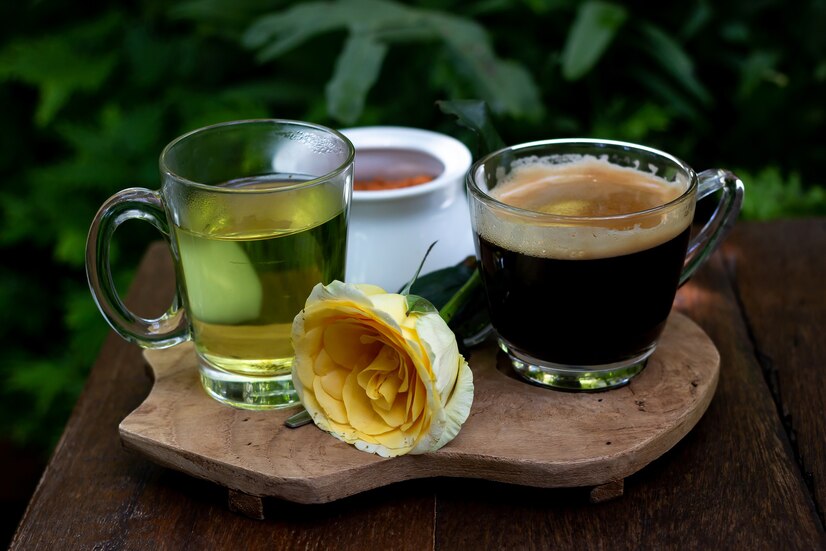Tea is the second most consumed beverage in the world, trailing only behind water. Tea enthusiasts often hold strong opinions about their preferred type of tea, whether it’s the robust flavor of black tea or the delicate taste of green tea. Interestingly, both black tea and green tea originate from the same plant, Camellia sinensis. However, the differences in their processing and oxidation result in distinct variations in taste, color, and health benefits. This article delves into the intricacies of Black Tea vs Green Tea, exploring their unique characteristics and helping you decide which one suits your preferences and health goals better.
Understanding the Basics
The Origin of Black and Green Tea
Both black tea and green tea come from the Camellia sinensis plant, native to Asia. The key differences between these two popular types of tea lie in their processing methods. Green tea leaves are quickly steamed or pan-fired to prevent oxidation, preserving their green color and fresh flavor. In contrast, black tea leaves undergo full oxidation, which darkens the leaves and intensifies the flavor.
Processing Methods
Green Tea Processing
- Plucking: Young tea leaves are hand-picked.
- Withering: Leaves are laid out to reduce moisture content.
- Steaming or Pan-Firing: This step halts oxidation and preserves the green color.
- Rolling: Leaves are rolled to shape them and release flavor compounds.
- Drying: Leaves are dried to reduce moisture further and stabilize the tea.
Black Tea Processing
- Plucking: Mature leaves are harvested.
- Withering: Leaves are spread out to wilt and reduce moisture.
- Rolling: Leaves are rolled to break cell walls and release enzymes.
- Oxidation: Leaves are fully oxidized, turning dark brown or black.
- Drying: Leaves are dried to lock in the flavors and halt oxidation.
Flavor and Aroma
Green Tea
Green tea is known for its light, fresh, and slightly grassy flavor. The steaming or pan-firing process preserves the natural green color and delicate taste. Depending on the variety, green tea can also have sweet, floral, or vegetal notes.
Black Tea
Black tea offers a bold, robust flavor profile with a rich, malty, and sometimes smoky taste. The full oxidation process intensifies the flavor, resulting in a dark, amber-colored brew. Black tea can also have hints of fruit, spice, and honey, depending on the specific type.
Health Benefits
Nutritional Composition
Both green tea and black tea contain bioactive compounds that contribute to their health benefits. These compounds include polyphenols, catechins, and flavonoids, which have antioxidant properties.
Green Tea Health Benefits
- Rich in Antioxidants: Green tea is high in catechins, particularly epigallocatechin gallate (EGCG), which has potent antioxidant effects.
- Weight Loss Aid: Green tea can boost metabolism and increase fat burning.
- Heart Health: Regular consumption of green tea is associated with a lower risk of cardiovascular diseases.
- Brain Health: The catechins in green tea can improve brain function and protect against neurodegenerative diseases.
Black Tea Health Benefits
- Antioxidant Properties: Black tea contains theaflavins and thearubigins, antioxidants that help reduce oxidative stress.
- Heart Health: Drinking black tea can improve cholesterol levels and lower blood pressure.
- Gut Health: Black tea promotes the growth of beneficial gut bacteria.
- Energy Boost: Black tea has higher caffeine content than green tea, providing a more significant energy boost.
Caffeine Content
Green Tea
Green tea generally contains less caffeine than black tea, making it a suitable option for those who are sensitive to caffeine or prefer a milder stimulant. On average, an 8-ounce cup of green tea contains about 20-45 milligrams of caffeine.
Black Tea
Black tea has a higher caffeine content, providing a more substantial energy boost. An 8-ounce cup of black tea typically contains about 40-70 milligrams of caffeine. This makes black tea a popular choice for morning or afternoon pick-me-ups.
Preparation and Brewing
How to Brew Green Tea
- Water Temperature: Use water that is about 160-180°F (70-80°C).
- Steeping Time: Steep the tea for 1-3 minutes to avoid bitterness.
- Tea-to-Water Ratio: Use about 1 teaspoon of green tea leaves per 8 ounces of water.
How to Brew Black Tea
- Water Temperature: Use boiling water, around 200-212°F (93-100°C).
- Steeping Time: Steep the tea for 3-5 minutes to extract full flavor.
- Tea-to-Water Ratio: Use about 1 teaspoon of black tea leaves per 8 ounces of water.
Culinary Uses
Green Tea in Cooking
Green tea’s delicate flavor makes it a versatile ingredient in various culinary applications. It can be used in:
- Smoothies: Add a teaspoon of matcha powder to your smoothie for a nutrient boost.
- Baking: Incorporate green tea powder into cakes, cookies, and muffins.
- Savory Dishes: Use green tea leaves to infuse flavor into broths, marinades, and rice dishes.
Black Tea in Cooking
Black tea’s robust flavor pairs well with both sweet and savory dishes. It can be used in:
- Chai: Brew a spicy chai tea with black tea, milk, and spices like cinnamon and cardamom.
- Desserts: Add brewed black tea to cakes, ice creams, and puddings for a unique twist.
- Marinades and Sauces: Use strong black tea as a base for marinades and sauces to add depth of flavor.
Cultural Significance
Green Tea
Green tea holds a special place in many cultures, particularly in East Asia. It is an integral part of Japanese tea ceremonies, symbolizing harmony, respect, and purity. In China, green tea is often consumed daily and is associated with various health benefits and cultural traditions.
Black Tea
Black tea has a rich cultural history, especially in Western countries and South Asia. In the United Kingdom, black tea is central to the tradition of afternoon tea, often enjoyed with milk and sugar. In India, black tea is the base for the popular beverage chai, a spiced tea that is an integral part of daily life.
Choosing the Right Tea for You
Personal Preferences
When deciding between black tea and green tea, consider your personal taste preferences. If you enjoy a bold, robust flavor, black tea might be your go-to choice. If you prefer a lighter, more delicate taste, green tea could be more to your liking.
Health Goals
Your health goals can also influence your choice of tea. If you’re looking to boost your metabolism and benefit from high antioxidant content, green tea is a great option. If you need a more substantial caffeine kick or are interested in gut health, black tea might be the better choice.
Conclusion
Both Black Tea vs Green Tea offer unique flavors, health benefits, and cultural significance. Whether you prefer the delicate taste of green tea or the robust flavor of black tea, both can be a delightful addition to your daily routine. By understanding the differences in their processing, nutritional content, and preparation methods, you can make an informed choice that best suits your taste and health preferences Black Tea vs Green Tea.
In the end, the choice between black tea and green tea comes down to personal preference and individual health goals. Both types of tea offer a wealth of benefits and can be enjoyed in various ways. So why not explore both and enjoy the rich diversity that tea has to offer? Whether you start your day with a cup of bold black tea or unwind in the evening with soothing green tea, you are partaking in a tradition that spans centuries and cultures Black Tea vs Green Tea.







